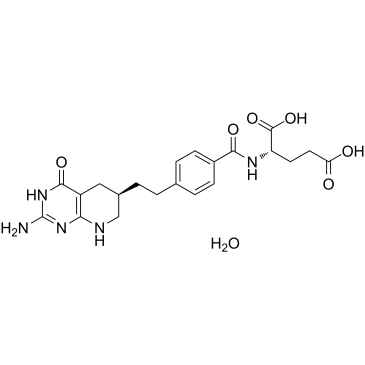| Description |
Lometrexol hydrate (DDATHF hydrate), an antipurine antifolate, can inhibit the activity of glycinamide ribonucleotide formyltransferase (GARFT) but do not induce detectable levels of DNA strand breaks. Lometrexol hydrate can further inhibit de novo purine synthesis, causing abnormal cell proliferation and apoptosis, even cell cycle arrest. Lometrexol hydrate has anticancer activity[1][2].
|
| Related Catalog |
|
| Target |
GARFT[1]
|
| In Vitro |
Lometrexol hydrate (DDATHF hydrate) binds tightly to GART, resulting in a rapid and prolonged depletion of intracellular purine ribonucleotides[2]. Lometrexol hydrate (1-30 μM; 2-10 hours) induces rapid and complete growth inhibition in L1210 cells[2]. Lometrexol hydrate (1 μM; 2-24 hours) induces cell cycle arrest in murine leukemia L1210 cells[2]. Lometrexol hydrate induces abnormal proliferation and apoptosis exist in neural tube defects (NTDs)[1]. Cell Viability Assay[2] Cell Line: Mouse leukemia L1210 cells Concentration: 1, 30 μM Incubation Time: 2, 4, 6, 8, 10 hours Result: Induced rapid and complete growth inhibition. Cell Cycle Analysis[2] Cell Line: L1210 cells Concentration: 1 μM Incubation Time: 2, 4, 8, 12, 24 hours Result: Caused a rapid loss of the G2/M phase population of cells and an early S phase accumulation of cells by 8 hours. By 24 h, the S phase population appeared to be slowly shifting to higher DNA content, and hence, from mid-to-late S phase.
|
| In Vivo |
Lometrexol hydrate (DDATHF hydrate; i.p.; 15-60 mg/kg; on gestation day 7.5) increases the rate of embryonic resorption and growth retardation in a dose-dependent manner[1]. Lometrexol hydrate (i.p.; 40 mg/kg) maximally inhibits GARFT activity after at 6 hours and thereafter gradually increases with time but remains significantly lower than control even at 96 hours. Levels of ATP, GTP, dATP and dGTP of NTDs embryonic brain tissue decreases significantly at 6 h, and more significantly over time[1]. Animal Model: C57BL/6 mice (7-8 week, 18-20 g)[1] Dosage: 15, 30, 35, 40, 45 and 60 mg/kg Administration: Intraperitoneal injection; on gestation day 7.5 Result: Increased the rate of embryonic resorption and growth retardation in a dose-dependent manner.
|
| References |
[1]. Xu L, et al. The effect of inhibiting glycinamide ribonucleotide formyl transferase on the development of neural tube in mice. Nutr Metab (Lond). 2016 Aug 23;13(1):56. [2]. Julie L Bronder, et al. Antifolates Targeting Purine Synthesis Allow Entry of Tumor Cells Into S Phase Regardless of p53 Function. Cancer Res. 2002 Sep 15;62(18):5236-41.
|
